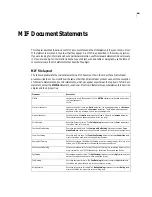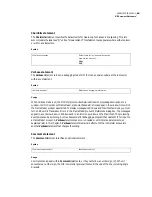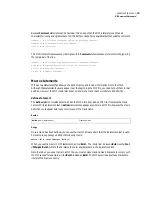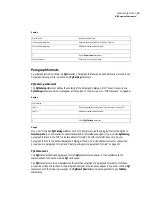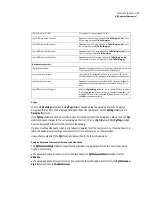
64
ADOBE FRAMEMAKER 6.0
Using MIF Statements
If your MIF statements are syntactically correct but cause unexpected results in the document, check for
mismatched ID numbers and check the placement of statements. Many MIF statements are position-
dependent and can cause errors if they appear in the wrong place in a file. For example, an
ATbl
statement
that comes before its corresponding
Tbl
statement causes an error.
Here are some additional tips for debugging MIF files:
•
Use the
Verbose
statement to generate comments. To debug a specific section of a MIF file, you can
precede the section with the
<Verbose Yes>
statement and end the section with the
<Verbose No>
statement.
•
Make sure angle brackets are balanced.
•
Make sure that MIF statement names are capitalized correctly. MIF statement names and keyword values
are case-sensitive.
•
Make sure that string arguments are enclosed in straight single quotation marks. (See “MIF data items”
on page 11 for an example.)
•
Make sure ID numbers are unique.
•
Make sure that every table anchor has a corresponding table instance, and that every table instance has
an anchor in the text flow.
•
Make sure that tag names with spaces are enclosed in straight single quotation marks.
•
Make sure paired statements are balanced. For example,
XRef
and
XRefEnd
statements must be paired.
•
Make sure that right angle bracket (>) and backslash (\) characters in text are preceded by a backslash.
•
Make sure that hexadecimal characters, for example
\xe6
, have a space after them.
Other application tools
The Frame Developer’s Kit (FDK) provides tools that you can use to write filters and to perform custom
document processing. The FDK includes the Application Program Interface (API), which you can use to
create a C application that can create and save documents, modify documents, and interact with the user.
The FDK also includes the Frame Development Environment (FDE), which allows you to make your FDK
clients portable to the platforms that FrameMaker supports.
MIF files can be used by C applications, text processing utilities, or UNIX shell scripts. You might want to
work directly with MIF files if you are filtering large numbers of files in batch mode. You also might want
to work with MIF files if you are doing simple document processing, such as changing a few tag names, or
if you are setting options for View Only documents.
You can use the FDK and MIF files together; for example, a database publishing application can extract
values from a database and write out the information as a table in a MIF file. An FDK client can then
automatically open the MIF file as a FrameMaker document.
Содержание FRAMEMAKER 6.0
Страница 1: ...MIF Reference Online Manual FrameMaker 6 0 Adobe ...
Страница 15: ...15 ADOBE FRAMEMAKER 6 0 Introduction ...
Страница 142: ...142 ADOBE FRAMEMAKER 6 0 MIF Document Statements update the text inset when changes are made to the original file ...
Страница 159: ...159 ADOBE FRAMEMAKER 6 0 MIF Book File Statements ...
Страница 232: ...232 ADOBE FRAMEMAKER 6 0 MIF Asian Text Processing Statements ...
Страница 252: ...252 ADOBE FRAMEMAKER 6 0 Examples ...
Страница 268: ...268 ADOBE FRAMEMAKER 6 0 MIF Compatibility ...

















